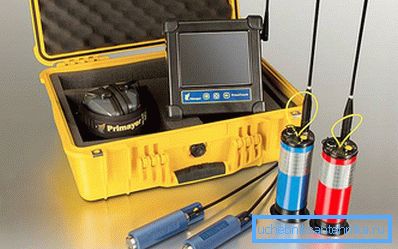How to detect leakage in plastic plumbing
Water plays an important role in human life. Water supply, in turn, performs the main function of transporting water from the source to the consumer. For the construction of a water supply system, pipes made of metal or cast iron were used. At present, we have already replaced the usual water pipes, new, improved models of pipes made of plastic have come. The consumer is provided with a wide variety of plastic water pipes, which differ not only in diameter, but also in terms of installation. And, although a plastic pipe has a longer service life than a metal pipe, there are still situations when it appears to flow.
Water leaks will certainly need to find and fix. After all, in addition to material damage, the pressure in the highway is also decreasing. This factor worsens the process of delivering water to the consumer. In the metal plumbing leak was searched using a signal generator. It was connected to the metal main and a special signal was sent, which picked up the receiver on the surface. It is impossible to transmit such a signal through a plastic pipe. But still, there are methods for finding leaks. To figure out how to detect leaks in plastic plumbing, let's look at some of them.
Water leakage detection methods

- The first method is based on the use of sensitive microphones. When a crack is formed in the water pipe, water under the influence of high pressure flows out, creating a kind of noise. Water leakage on a metal plumbing creates a high frequency sound. And on plastic plumbing creates a low frequency sound. With the help of these microphones, which are tuned to different frequencies, sounds are captured from the ground, indicating the location of a water leak.
- The second method is based on noise correlation. This electronic type of search is performed using a correlation leak detector. Two microphones are mounted at two points in the water supply and transmit the frequency of the noise to the device. Using the program, the device processes the data from the microphones and calculates the peak sound on both sides. This sound indicates the location of a water leak.
- The third method is based on filling a pipeline section with a safe gas. Basically it is a mixture of 95% nitrogen and 5% hydrogen. Due to the small number of hydrogen molecules, gases escape from the cracks formed in the pipe. They go up through layers of soil. They can penetrate asphalt and even concrete. On the surface, this gas is caught by special sensors that indicate the place of water leakage.
- The fourth search method can be called mechanical. It consists in measuring the pipe section with pressure. A separate section of the water supply is taken and special pillows are inserted along the pipe on both sides. They inflate and completely seal the tube. Air pressure is injected into the sealed section of the pipe and is measured after some time. If the pressure remains unchanged, it means that there is no water leakage in this area. Well, if the pressure drops, then the search is conducted in the right direction. Next, the pillow moves along the pipe, and again the pressure is pumped. This procedure is performed until a water leakage point is identified.
Having considered the four methods for finding leaks in plastic water mains, we can distinguish the second method. It is based on a scientific approach and is used more in practice. So let's take a little closer look at what he is.
Noise correlation

The water coming out of the tap hole creates noise. It is accompanied by vibration and acoustic signals distributed over a large part of the aqueduct. Near the leak, this signal extends to the ground. The characteristics of the signal are influenced by the pressure of the supplied water, the diameter and thickness of the pipe walls, the size of the water leakage and the material from which the pipe is made.
Correlation leak detectors are used to analyze these signals. The signal is measured by a hydrophone and an accelerometer, and after conversion, the leak detector is analyzed. The principle of operation of the leak detector consists in the correlation of incoming signals from two sensors installed at two edges of the water supply system. If there is water leakage in this area, a steady peak is created in the histogram area.
Based on the processed data, the exact leakage from the first sensor is calculated. It is calculated by the formula: Lone= (D-vt delays) / 2.
- Lone - the distance from the first sensor to the leakage in the water supply;
- D is the total distance between two sensors installed at the two edges of the water supply section;
- v is the speed of sound propagation through the water supply system;
- t delays - the delay time calculated on the basis of the signals of mutual correlation.
The accuracy of the calculation of the water leakage location depends on the type of sensors, their correct installation location and accurate signal processing.
Video
This video demonstrates how a network leak detection system works: